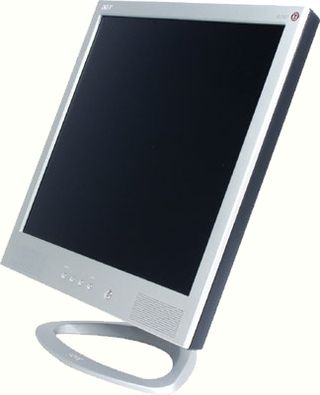Affordable 19" LCD Monitors
Acer AL1931

If this is not the best 19" monitor on the market, it is at least the best looking and slimmest of the lot. It is just 17 centimeters deep, including the base. The imitation-metal housing is ascetically acceptable. The buttons on the front are discreet, and there are many inputs at the back: DVI, D-Sub, RCA and S-Video. You can hook it up to a digital camera, camcorder, DVD player, VCR, console, and so on.
The downside is that such slenderness means an external transformer has to be used and the base, however beautiful, is not height-adjustable.
Colors

The AL1931 is certainly the first of the monitors tested with the best possible default parameters, at least when it is used digitally via the DVI input. In this case, any further tweaking we did to brightness and contrast only spoiled the original image. So in DVI, we calibrated by setting the colors on USER (i.e. the red, green, and blue with their original values of 50), a contrast at 50, and a brightness at 100.
Things change when the monitor is in analog mode. The default image here is too bright. Calibrating at 45 for contrast and 100 for brightness gave a much better picture, though not quite as good as in DVI.
6500K
The profile can be downloaded below. Install it in C:\WINDOWS\system32\spool\drivers\color. Then you activate it by going to advanced display properties, then Color Management. Add the profile and select it as default.
Stay on the Cutting Edge
Join the experts who read Tom's Hardware for the inside track on enthusiast PC tech news — and have for over 25 years. We'll send breaking news and in-depth reviews of CPUs, GPUs, AI, maker hardware and more straight to your inbox.

94% of the colors (DeltaE <2) were adequately displayed. 81% (DeltaE <1) of them were perfectly displayed. Only the 3% darkest ones (DeltaE >3) came out poorly, and in fact they are impossible to display on this monitor.
At this point, it is interesting to mention that, apart from the interfaces, the Sony SDM-S93 (test further on) and the Acer AL1931 have the same Fujitsu panel with the same reference. Only the electronics differ. Acer is the winner in this little contest. Its colors after calibration are truer compared to the Sony monitor.
On the other hand, the response time, crystal reaction, and hence the picture in videos and games are the same. The results that follow therefore also apply to the SDM-S93.
Most Popular


